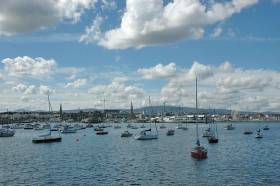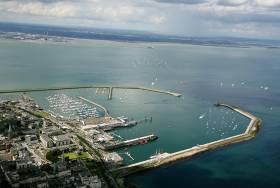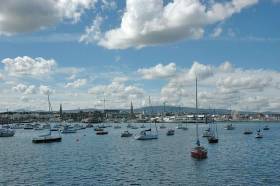Displaying items by tag: Cruise Berth
#CruiseBerth - Afloat.ie has learned that the Dun Laoghaire Combined Clubs (DLCC) will not seek a judicial review of An Bord Pleanála’s approval of a scaled-down cruise berth for Dun Laoghaire Harbour.
DLCC members, who welcomed the 250m limit on the proposed cruise liner berth, recently met to discuss the planning decision and whether a review was warranted based on interpreted material changes to the permission sought, based on objections or suggestions from DLCC and others.
However, it was agreed not to launch a joint appeal for reasons of cost, and that the reduced maximum scale of the cruise berth changes its commerciality such that may never proceed.
However, the joint decision does not prevent any of DLCC’s constituent yacht clubs or individuals from seeking judicial review before the deadline of Wednesday 28 December, three weeks from today.
Meanwhile, DLCC members are seeking contributions to cover a shortfall associated with the extended oral hearing over the cruise berth proposals.
Dun Laoghaire Yacht Clubs 'Welcome' 250m Limit on Cruise Ship Berth
Dun Laoghaire's Combined Clubs (DLCC) say in a joint statement that 'Dun Laoghaire Harbour Company lost its application to develop a facility for super-sized cruise ships'. The clubs have 'welcomed' yesterday's decision of An Bord Pleanala to limit any proposed development to accommodate a maximum size of cruise ship to 250m.
The DLCC represents the Dun Laoghaire Motor Yacht Club, Dublin Bay Sailing Club, Royal Irish Yacht Club, Royal St. George Yacht Club, Royal Alfred Yacht Club and the National Yacht Club.
DLCC convenor Liam Owens says 'This removal of the threat of the supersized cruise ships secures the future of this premier location for the benefit of all Dun Laoghaire residents, watersports users, walkers and all those visitors and locals who value this historic amenity'
'We welcome the decision of An Bord Pleanala to limit cruise ships to 250m, similar to those ships already being accommodated in the Harbour and to which we have no objection', Owens says.
The DLCC statement 'regrets that the Board has overruled its Inspector’s conclusions that the proposed development was contrary to the National Ports Policy, and that the economic case for the development was not sustained'.
The statement contonues: 'We are very pleased that Dun Laoghaire Rathdown County Council, the future owners of the Harbour concurs with and has included a similar limitation in its Development Plan. We look forward to working with DLRCC to develop a National Watersports Centre in Dun Laoghaire Harbour as specified in the DLRCC’s Development Plan for the benefit of all'.
#DunLaoghaire - The Dun Laoghaire Combined Clubs will hold a fundraising day next week to help cover costs associated with last year's oral hearing over the proposed harbour terminal for cruise liners.
Harbour Heritage Day on Thursday 16 June aims to "galvanise the sailors to show solidarity and not only to contribute but to underwrite the €48,000 needed to clear our debt", according to a letter to members from the National Yacht Club.
Boat owners are encourage to arrange collection from their crews, and voluntary donations can be made directly via bank transfer (contact the club for details via nyc.ie).
No decision has yet been made on the controversial Dun Laoghaire Harbour cruise berth proposals after An Bord Pleanála deferred its ruling in January, as previously reported on Afloat.ie.
#CruiseBerth - The Dun Laoghaire Combined Clubs (DLCC) are seeking donations from members to cover some €100,000 in legal costs associated with participation in the oral hearing over the proposed cruise liner terminal for Dun Laoghaire Harbour.
The hearings hosted by An Bord Pleanála, which began on 14 October, ran 10 days over the expected seven-day duration and saw some heated exchanges regarding the controversial plans.
Costs remained broadly in line with original predictions, according to a waterfront Commodore, one of the six member clubs of the DLCC.
However, as a letter of appeal from DLCC convenor Liam Owens underlines, "it was always understood that the clubs had neither the resources nor the mandate to commit to this undertaking" alone, particularly after the four main clubs covered the €20,000 cost of the original objection.
While an application for full costs has been submitted to An Bord Pleanála, it may not be granted – making an appeal for contributions from all harbour users all the more necessary.
Owens writes: "I want you to demonstrate your appreciation by sending a payment to the DLCC now for whatever you can afford. Some individuals among the sailing community have already donated significant sums.
"I believe we have achieved something very significant and I know you love your harbour," he adds
An Bord Pleanála's decision on the matter is due next month.































































